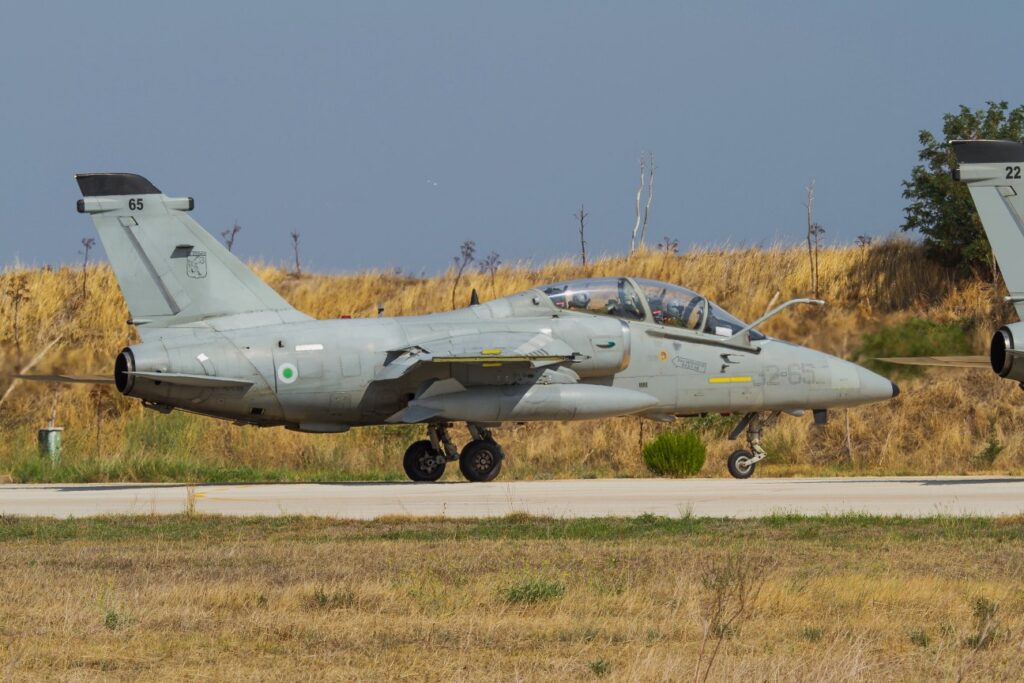Light in the sky with passion in the heart
History of the 101th Flight Group
by Gigi Iacomino
THE FIRST OPERATING CYCLE
The 101th Dive Bombing Group was formed on March 5, 1941 at the Varese airport of Lonate Pozzolo.Articulated on the 208th and 209th Squadrons, the Group was equipped with the famous German-built dive bombing aircraft, Junkers Ju.87 B / R “Stuka”, better known in the departments of the Royal Air Force, with the nickname of ” Picchiatelli “; detail that suggested the adoption, as the official banner of the 101st Group, of a woodpecker carrying a bomb between its legs.
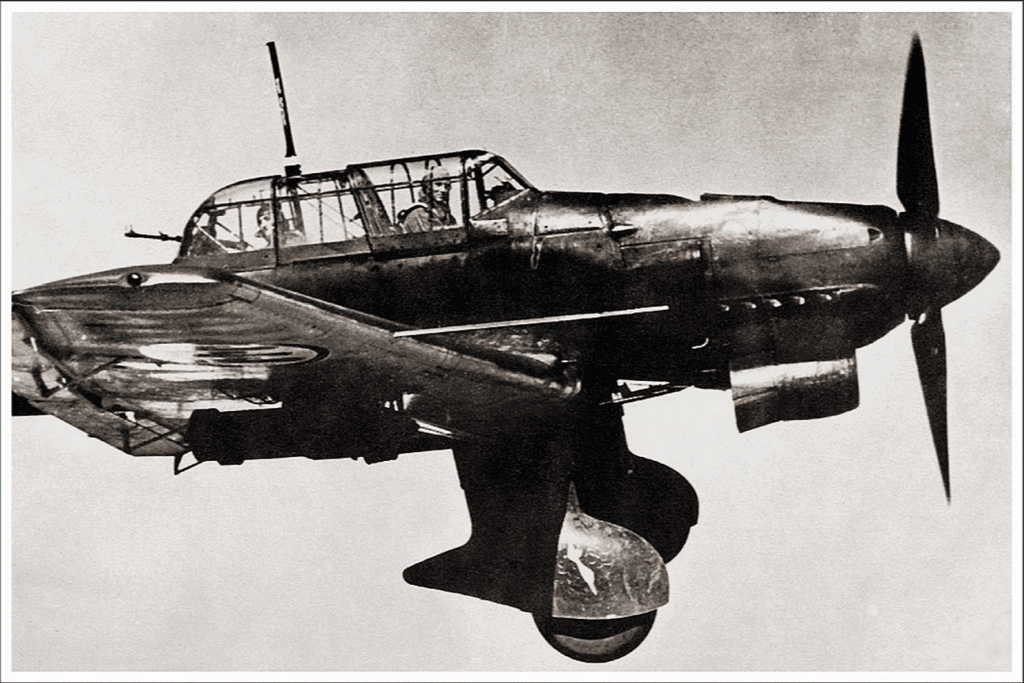
On the 7th March following the Group’s first aircraft (208th Squadron), they moved to Lecce airport from which they began to carry out their first war missions on the Greek front. In a few days the 101th aircraft, which in the meantime had also been joined by the 209th Squadron, demonstrated the Stuka’s war effectiveness and managed to achieve important operational results.On April 1, 1941, at the disposal of the Command of the 4th Air Team, the Group was transferred to the Albanian airport of Tirana, on which the 238th Squadron took over, transferring the 209th to the 97th Dive Bombing Group.
U 87B-2 “Picchiatello” of the 101st Group B.a.T. in flight. (Gigi Iacomino collection)
Taking off from the new operational headquarters, the 101st Group aircraft carried out an effective work of
annihilation of the defensive deployment of the Greek army, while ensuring significant tactical support to the departments of the Italian Royal Army.

Starting from the following April 6, the date on which Italy had declared war on Yugoslavia, the Group was committed on both fronts managing to always achieve maximum results, albeit at the price of painful losses, as evidenced by the concession of the M.O.V.M. (To memory) to the second lieutenant pilot Vittorio Bragadin.At the end of May 1941, after the successful completion of the cycle of missions on the Balkan front, the 101st was transferred to the Sicilian airport of Trapani-Milo to take part in a new operating cycle aimed against the British fleet in the Mediterranean and its stronghold represented by the island of Malta.
of Sicily, the 101st Group aircraft were engaged in a series of exhausting missions conducted both against the naval units of the Mediterranean Fleet and against airports and the port of Malta; missions that, despite the mixed results, were conducted by the Group’s crews always with courage and a spirit of sacrifice rewarded with the granting of various decorations, among which the M.O.V.M. (To memory) granted to the pilot lieutenant Carlo Seganti.

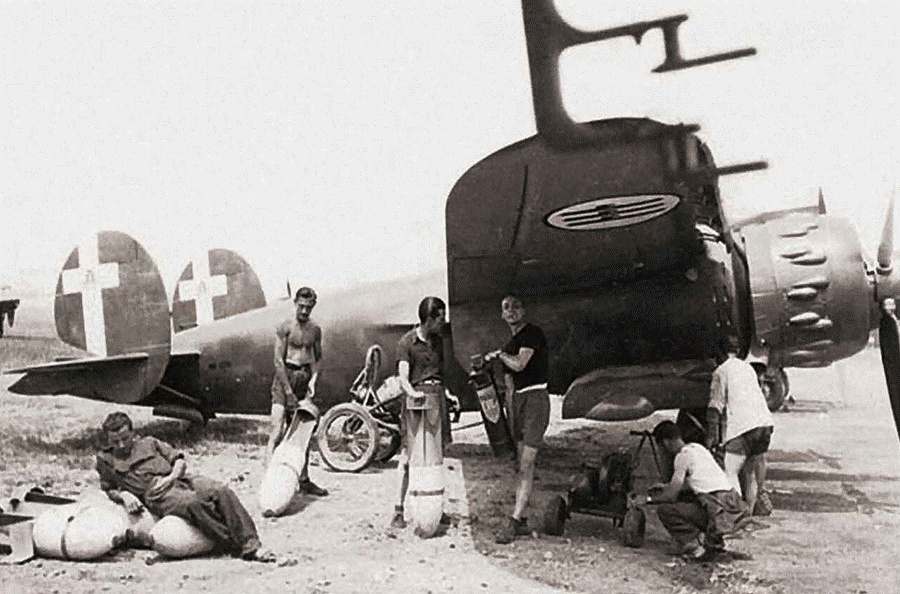
A Ju.87R of the 101st Group.
(Gigi Iacomino collection)
Specialists of the 101st Group alongside Ba.88M of the Department. (Gigi Iacomino collection)
In this span of missions, there was also a clearing up of the Libyan airport of Castelbenito (26 November – 12 December 1941) which, although there were no operational missions to register, was the prelude to a much more intense and dramatic operating cycle.At the end of 1941, the now exhausted 101st Group, was again transferred to the airport of Lonate Pozzolo to be reorganized and re-equipped with newly built aircraft. In the spring of 1942, the possibility of receiving other Junkers Ju.87B and R, and after having run the risk of being re-equipped with the mediocre Breda Ba.88, the Department was finally equipped with FIAT CR42 AS biplanes, taking on the new denomination of 101 ° Autonomous Diver Group.
FROM THE FORNACE OF EL ALAMEIN TO THE WAR OF LIBERATION
Entirely re-equipped with FIAT’s anachronistic biplanes and joined the reconstituted 5th Stormo Tuffatori (15 May 1942), in the summer of the same year the 101st was transferred to the Sicilian airport of Catania-Gerbini to perform the escort task flight to the Italian-German naval convoys bound for the ports of North Africa.On July 20 the 101st was transferred again to Castelbenito where, inserted in the 5th Air Team, he began a long series of missions against the Desert Air Force airports and the departments of the 8th British Army.

Operating uninterruptedly on the front line (July-December 1942), the 101st pilots engaged in hard battles against modern and more powerful adversary aircraft, managing, with courage and determination, to often have the best until reaching the decisive battle of El Alamein, which marked the fate of the war on North African soil. Returning to Italy at the end of December 1942, the Group, together with the entire 5th Wing, was re-deployed to Lonate Pozzolo where, waiting to receive the new Reggiane fighter-bomber Re.2002 Ariete, operated for a short time on some CR42s, a FIAT G.50 two-seater and a Reggiane Re.2001.In the first week of July 1943, fully re-equipped with the Re.2002, and after taking the name of 101st Assault Group, the Department began to move to the bases of southern Italy to participate in actions to combat the landing of Anglo-Americans on the coasts of Sicily first and then on those of Calabria.
The insignia of the 101st Fighter Group
of the Republican National Air Force.
(Gigi Iacomino collection)

A Re.2002 used by the 101st Group in flight over the Capitanata. (Gigi Iacomino collection)
Operating initially from the airports of Crotone and Botricello, and later from that of Taranto-Grottaglie, the pilots of the Group engaged in a difficult work to contrast the overwhelming opponent who, although he achieved appreciable results, was paid by them at a high price. , as evidenced by the concession of the MAVM (To memory) to pilot colonel Guido Nobili and M.O.V.M. (To memory) to the pilot captain Gino Priolo.The Armistice date caught the 101st Risky Group in the Manduria field; however, on September 8, 1943 it did not mean for the Department the end of the war, but the beginning of a new and important operating cycle that would have led it to be one of the pillars of the Royal Air Force (Cobelligerant) in the Liberation War.
Equipped with tricolor cockades, which replaced the previous lictor bundles, the now worn out Re.2002 of the Group began a long series of interdiction and contrast missions to the German military departments which, furiously, took revenge on the Italians who, in accordance with the clauses of the armistice, had become the new enemies. The 101st Group pilots were sent on missions to the Greek islands of Kefalonia and Corfu, and to numerous other targets located in the Aegean, carrying out actions that for the courage and determination earned the M.A.V.M. (To the memory) to the lieutenant pilot Felice Fox and to the sergeant major pilot Marino Zaffagnini.
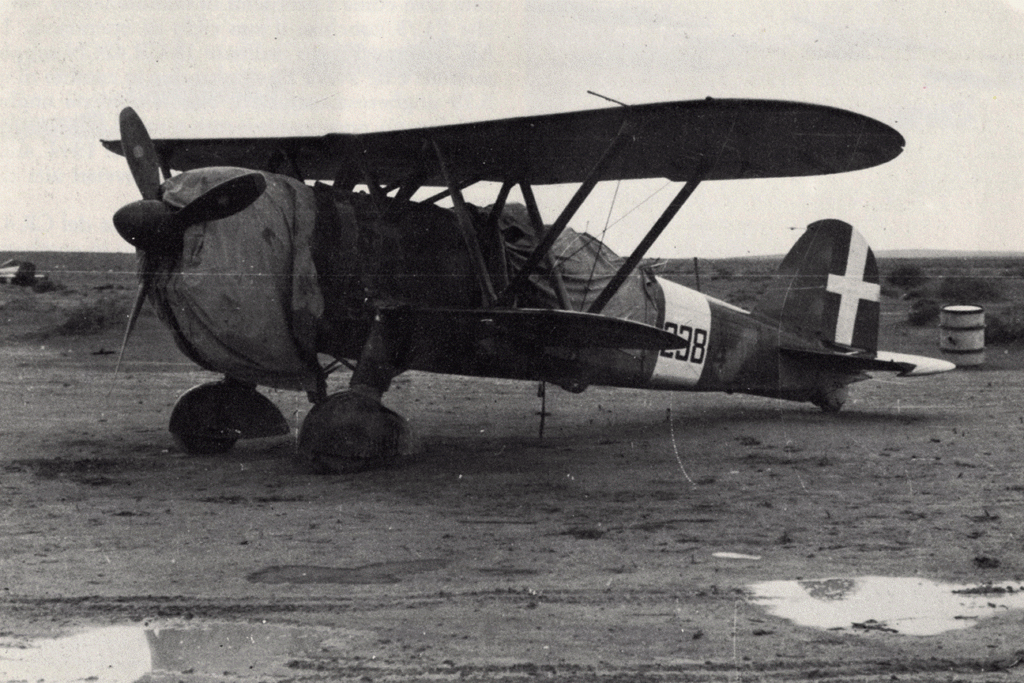
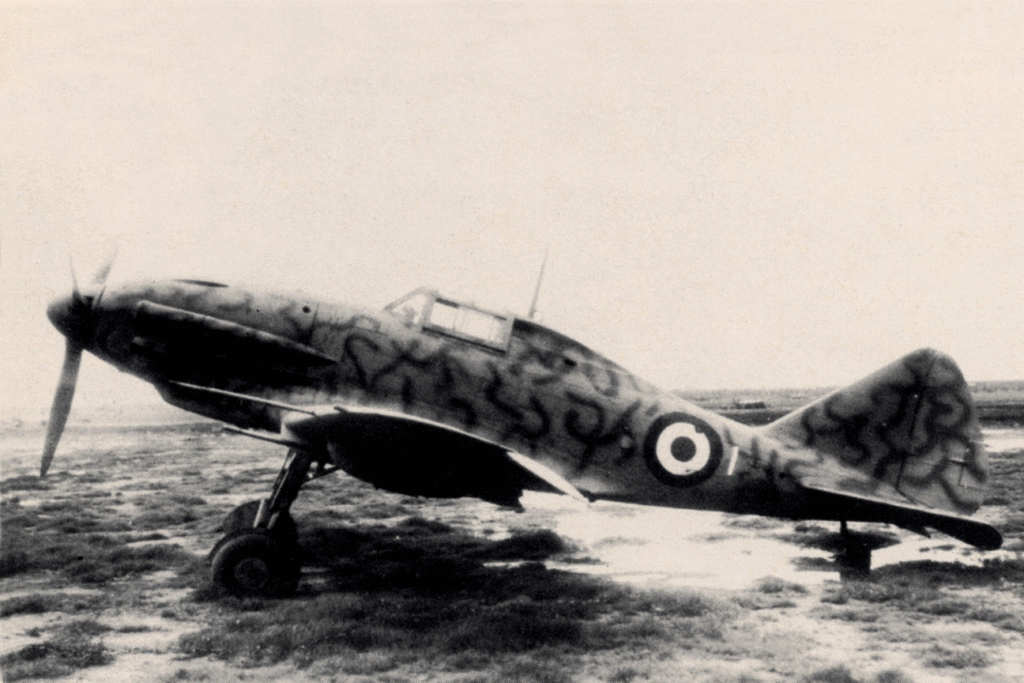
A Fiat CR.42AS of the 238 ^ Squadriglia, on the field of El Neofilia. (Gigi Iacomino collection)
One of the Re.2001 of the Regia Aeronautica (Cobelligerante), in 1944. (Gigi Iacomino collection)
After this first operating cycle, the pilots of the “new” 101st Terrestrial Fighter Group (part of the Balkan Air Force), flying on Re.2002, Re.2001 and Macchi C.202, and moving from time to time to Foggia airports- Palata, Lecce-Levarano, Lecce-Galatina and Campobasso-Nuova, actively participated in the difficult Liberation War.While in the south of Italy the 101st Terrestrial Fighter Group made its contribution to the liberation of Europe from the Nazi yoke, in the north of Italy another 101st Autonomous Fighter Group was set up which, part of the Republican National Air Force, sought to defend the cities of the north from the incursions of Anglo-American bombers.
However, the existence of this umpteenth 101st Group, later renamed 101th Complementary Hunting Group, was short-lived (October 1943 – March 31, 1944) and, upon its dissolution, its pilots were assigned to the 1st and 2nd Hunting Group, while a part of the ground personnel gave birth to the Forlì Battalion, and another joined the Folgore Paratroopers Regiment. The only trace left of the unfortunate 101st Hunting Complementary Group is its motto “Lightning in the sky with passion in the heart” which, after the war, became an integral part of the 101st Flight Group.
THE AFTER WAR


A Macchi C.205 of the 101 ° Caccia Group.
(Gigi Iacomino collection)
Flight line of the Spitfire Mk.IX of the 101st Group.
(Gigi Iacomino collection)
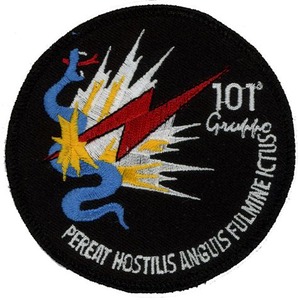
In 1953 the acrobatic patrol of the “Thundering Jets” (1st June ’53 – end of July ’55) was formed within the 5th Air Force Bomber Fighter (which included several pilots of the 101st, which successfully participated in numerous events both in Italy and abroad. In those same years the Group adopted the symbol of the red lightning which, applied to the wing tip tanks, allowed the immediate identification of its aircraft. After successfully participating in the Delta operation in 1956, the 5th Air Brigade, was transferred to the Rimini-Miramare airport where, the following year, the 101st Group was re-equipped with the new Republic F84F Thunderstreak; in the following months, the Group adopted the famous coat of arms of the red lightning that pierces the snake, and the Latin motto.
The F84F, with which the acrobatic patrol of the “Thundering Jets” was reconstituted in the two-year period 1959-60, equipped the Group until almost the mid-1960s, when it gave way to Lockheed F / RF104G Straighter. Despite the brilliant results achieved, the stay of the Star Hunter at the Group was short-lived (1964-66) and the 101st, converted to the F84F, in 1967 was transferred to the Cervia airport to become part of the reconstituted 8 °Stormo.
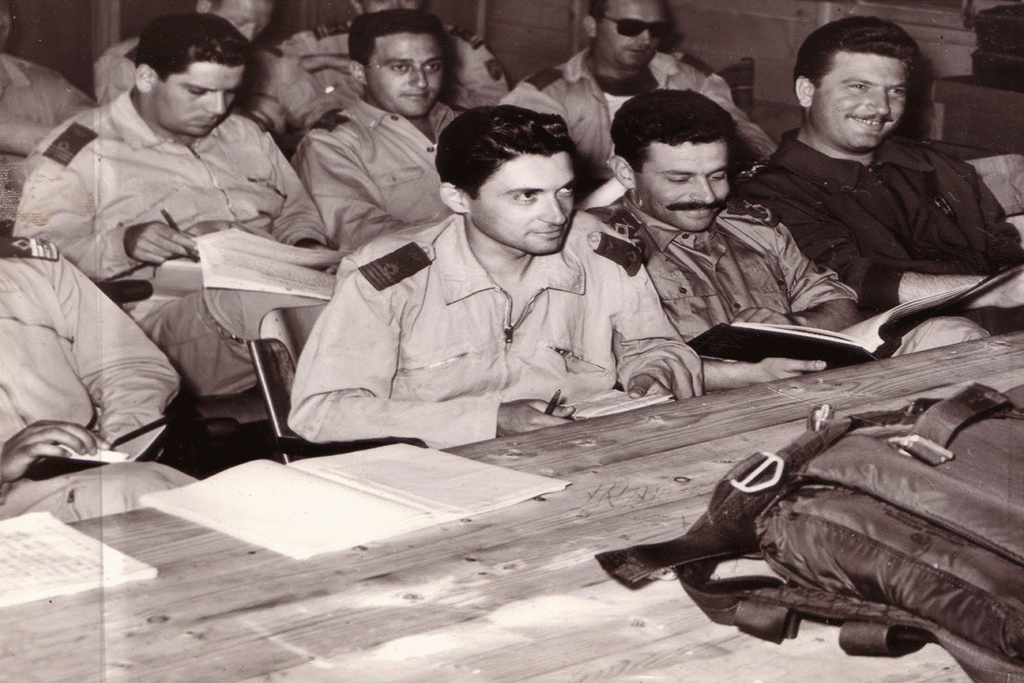
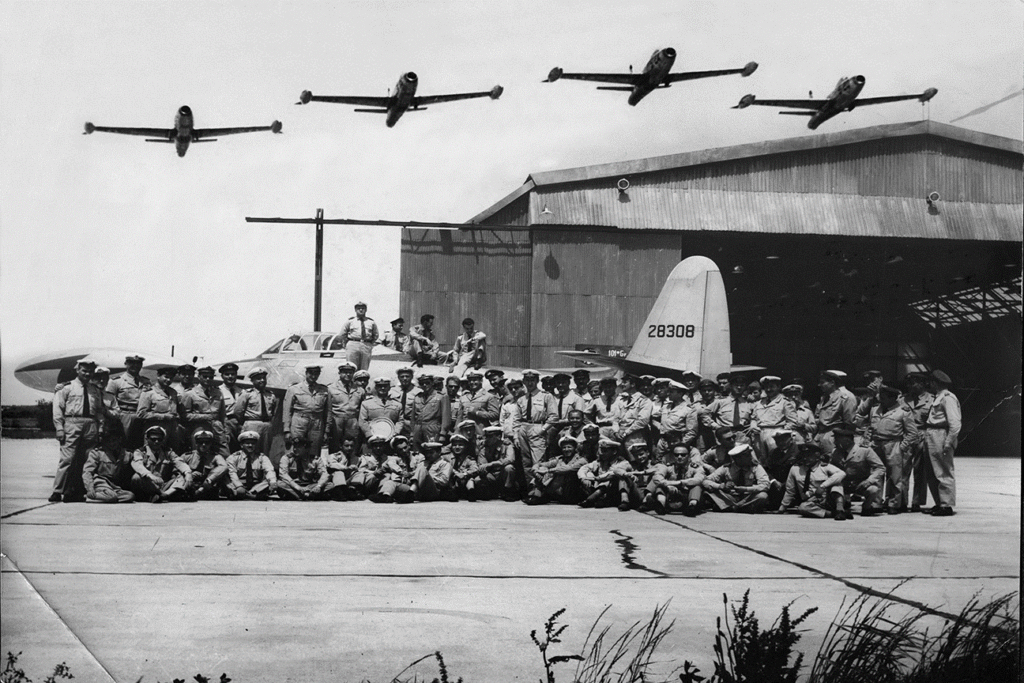
Villafranca (Verona), early 1950s. Pilots of the 101st Group photographed while they are intent on following the course for the transition on F84G jet aircraft.
(Gigi Iacomino collection)
The Thundering Jets fly over the staff of the 101st Group.
(Gigi Iacomino collection)

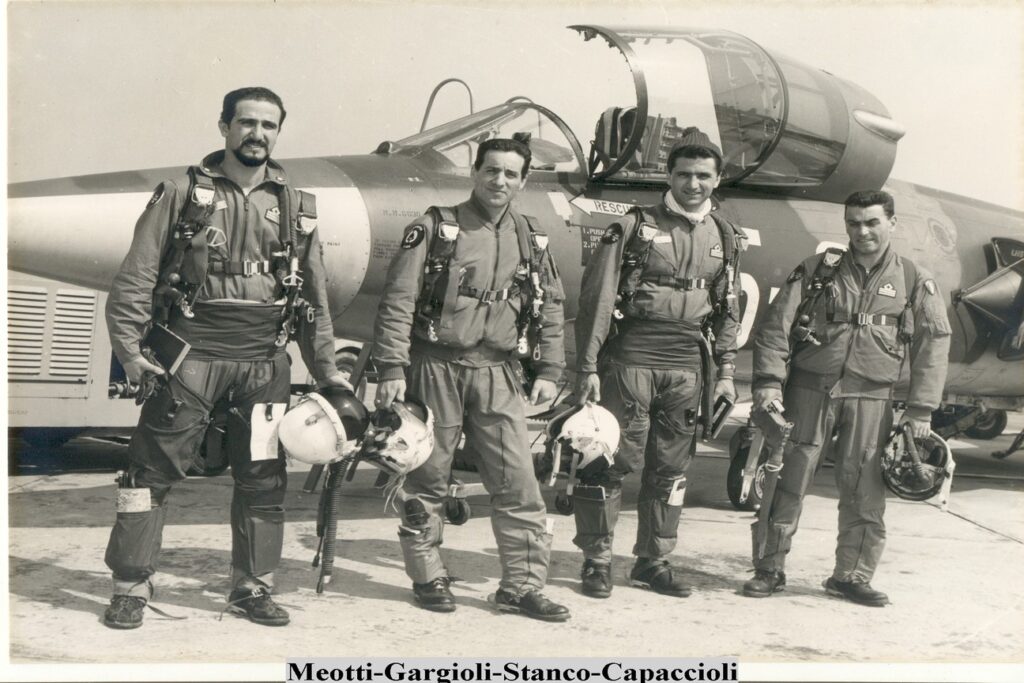
The 101st F84Fs are reviewed in Istrana.
(Gigi Iacomino collection)
101st pilots in front of an RF104G.
(Gigi Iacomino collection)
In 1970 the Group received the first specimens of the FIAT G91Y Yankee tactical fighter-bomber, which took care of both the pre-operational phase, and the technical and tactical refinements, taking the name of 101 ° C.B.R. Group.
In the course of 24 years of uninterrupted activity, the Group Yankees took part in as many as sixteen NATO tactical assessments (Attack and Recce roles), numerous exercises, foreign operations and Squadron Exchange; last department in line i G91Y, on 1st December 1994 the 101st Group, having removed its aircraft, was placed in a square position.
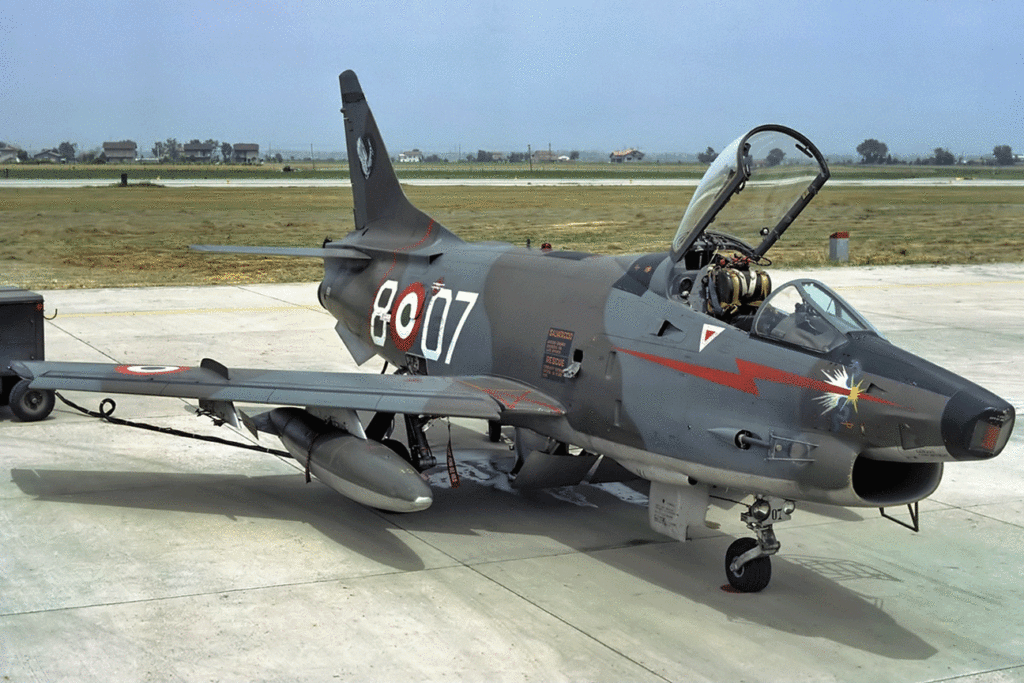

FIAT G91Y Yankee of the 101 ° C.B.R.
(Air Force)
G91Y Special Color 50,000 flight hours of the
101st Group.
THE YEARS OF GHIBLI
On July 31, 1995 the 101st Group was reconstituted on the air base of Amendola (Foggia) where, equipped with AM-X and AMX-T Ghibli aircraft, it assumed the double role of O.C.U. (Operational Conversion Unit), and attack (F.B.A.). Since its reconstitution, the Group took part in numerous national and NATO exercises, such as the T.L.P. (Belgium), Mothia, Dynamic Mix, Central Enterprise 97 (Germany) and Maple Flag XXXI (Canada).
Starting in the late 1990s, as part of the commitments undertaken by NATO and the UN, the Group participated with its own aircraft and pilots, in the actual Alba and Deliberate Guard operations on the territories of the former Yugoslavia while in 1999, its crews, framed within the AM-X Operating Section based on Amendola airport, carried out numerous war missions aimed at resolving the crisis in Kosovo.In the same year, after the war operations in the area of ex-Yugoslavia, the pilots of the 101st took part in the Bright Star exercise (Egypt) and, subsequently and for the first time, in a re-deployment in Israel.


AMX-T of the 101st Group O.C.U. taxiing along the flight line of Amendola airport on the occasion of the tenth anniversary of the reconstitution of the Department.
(Gigi Iacomino collection)
Personnel of the 32nd and 51st Wing.
Including several pilots and specialists of the 101st Group, classified in the Task Force Black Cats.
(Gigi Iacomino collection)
In 2000 the Group, while continuing to guarantee support for the Joint Guardian operation, participated in national and foreign exercises including Clean Hunter, Mothia and TLP. The 101st year took part in the A.M.A. 2001 (Goose Bay – Canada), and the 32nd Wing Op Eval, successfully repeating itself in 2002, with participation in the Op Eval NATO in Amendola, and at the Red Flag on the Nellis air base (Nevada).
In the following years the 101st O.C.U. continued to play its primary role of operational conversion for pilots destined for the AM-X line while ensuring the important standardization of the training and operational use of the weapon system. The skills of the Group’s personnel were instrumental in the success in the preparation and use of the new version of the AM-X, the ACOL, and the survival techniques of the Ghibli against surface-to-air missile threats (Valtar 05 in China Lake – USA ).
In addition to continuing the experimentation of new tactics, aimed at allowing the AM-X weapon system, to deal efficiently with the ever-increasing challenges, during the first decade of the 2000s the pilots of the 101st Group took part in the numerous commitments to which were called the departments of the flight line of the Ghibli culminated, successfully, in the participation in the task force of the Black Cats in Afghanistan.

Special Color created on the occasion of reaching the 10,000 flight hours of the 101st Group on the Ghibli. (Gigi Iacomino collection)
On July 23, 2014, as part of the operations for the acquisition of the F35A / B Lightning II by the Air Force, the 101st O.C.U. Group he left the dependencies of the 32nd Wing to join the 51st on the Istrana base. Under the insignia of the famous black cat, the Group continued to operate in its primary task of preparing the pilots destined for the AM-X line until 3 November 2016. On that date, in compliance with the provisions issued by the Air Force General Staff in view of the disposal of the AM-X aircraft, the 101st O.C.U. was placed in a square position.

